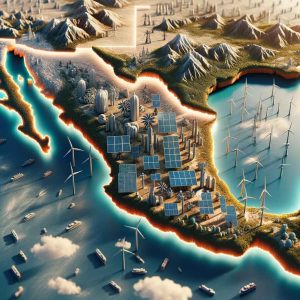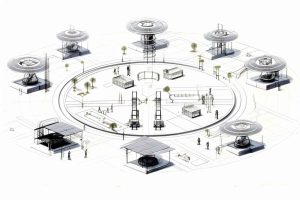Onsite power purchase agreements (PPAs) are contracts that allow businesses to buy electricity from renewable energy sources located on their premises. They offer several benefits, such as reducing greenhouse gas emissions, lowering energy costs, and improving energy security. In this guide, we will explain what onsite PPAs are, how they work, and what factors to consider before signing one.
Todo sobre
Understanding Onsite Power Purchase Agreements (PPAs)
If you are looking for a way to save money on your electricity bills, reduce your environmental impact, and increase your energy security, you might want to consider an onsite power purchase agreement (PPA). An onsite PPA is a contract between you and a renewable energy developer, who will install and operate a renewable energy system (such as solar panels or a wind turbine) on your property. You will pay the developer a fixed price for the electricity generated by the system, which will be lower than the market rate. Here are some of the benefits and key components of an onsite PPA.
Benefits of Onsite PPAs
– Price Stability: You will know exactly how much you will pay for electricity for the duration of the PPA, which can be 10 to 25 years. This will protect you from volatile and rising electricity prices in the market.
– Energy Security: You will have a reliable source of electricity on your premises, which will reduce your dependence on the grid and lower the risk of power outages and disruptions.
– Sustainability: You will reduce your greenhouse gas emissions and support the transition to a low-carbon economy by using clean and renewable energy.
– Tax Benefits: You may qualify for tax credits and deductions for installing and using renewable energy systems.
Key Components of Onsite PPAs
– Parties: The PPA will clearly identify you as the buyer of electricity and the developer as the seller and owner of the renewable energy system.
– Electricity Specifications: The PPA will define the amount, quality, and features of the electricity that the developer will sell to you.
– Price and Payment Terms: The PPA will specify the fixed price per kilowatt-hour (kWh) that you will pay to the developer and the frequency and method of payment.
– Delivery: The PPA will outline how the electricity will be delivered to you, usually through a direct connection to your facility.
– Term and Termination: The PPA will establish the length of the contract, which can range from 10 to 25 years, and the conditions for ending or renewing the contract.
– Maintenance and Repair: The PPA will define who is responsible for maintaining and repairing the renewable energy system, usually the developer.
– Insurance: The PPA will outline what kind of insurance coverage is required for the renewable energy system and the electricity produced.
If you are interested in learning more about onsite PPAs or finding a suitable developer for your project, please contact us today. We are experts in renewable energy solutions and can help you find the best option for your needs.

How Onsite PPAs Differ from Offsite PPAs
Are you looking for ways to reduce your energy costs and carbon footprint? If so, you might want to consider entering into a power purchase agreement (PPA) with a renewable energy provider. A PPA is a contract that allows you to buy electricity from a renewable energy project at a fixed price for a specified period of time. However, not all PPAs are the same. Depending on your needs and preferences, you can choose between an onsite PPA or an offsite PPA. In this blog post, we will explain the main differences between these two types of PPAs and how they can benefit your business.
Onsite PPAs: Generating Electricity on Your Own Property
An onsite PPA, also known as a behind-the-meter PPA, is a PPA where the renewable energy project is located on your property. For example, you can install solar panels on your rooftop or wind turbines on your land and enter into a PPA with the project developer. The developer will finance, install, and maintain the project, while you will pay a fixed price for the electricity generated by the project. The main advantage of an onsite PPA is that you can use the electricity directly from the source, without relying on the grid. This can help you avoid grid fees, transmission losses, and price fluctuations. Moreover, an onsite PPA can enhance your energy security, resilience, and sustainability.
An offsite PPA, also known as a merchant PPA, is a PPA where the renewable energy project is located away from your property. For example, you can buy electricity from a large-scale solar farm or wind farm that is connected to the grid and enter into a PPA with the project developer. The developer will sell the electricity to you through the grid, while you will pay a fixed price per unit of electricity. The main advantage of an offsite PPA is that you can access more diverse and scalable sources of renewable energy that may not be available or feasible on your property. Moreover, an offsite PPA can help you hedge against future increases in electricity prices and support the development of new renewable energy projects.
Offsite PPAs: Buying Electricity from Remote Projects
Key Distinctions between Onsite and Offsite PPAs
The following table summarizes the key distinctions between onsite and offsite PPAs:
Feature
| Generation Location |
| Project Ownership |
| Electricity Delivery |
| Pricing Structure |
| Maintenance Responsibility |
| Tax Benefits |
Onsite PPA
| Buyer’s premises |
| Project developer |
| Direct connection to buyer’s facility |
| Fixed price |
| Project developer |
| Potential tax incentives for renewable energy systems |
Offsite PPA
| Remote generation facility |
| Project developer |
| Through the electricity grid |
| Fixed price or indexed price |
| Project developer |
| Limited tax benefits |
If you are looking for a way to power your business with renewable energy, you may have come across the option of a power purchase agreement (PPA). A PPA is a contract between a buyer and a seller of electricity, where the seller agrees to provide electricity from a renewable energy source at a fixed price for a specified period of time.
There are two main types of PPAs: onsite and offsite. An onsite PPA involves installing a renewable energy generation facility on the buyer’s property, such as solar panels or wind turbines. An offsite PPA involves purchasing electricity from a renewable energy project located elsewhere, such as a solar farm or a wind park.
How do you decide which type of PPA is best for your business? Here are some considerations to keep in mind:
- Space: Do you have enough space on your property to host a renewable energy facility? Onsite PPAs require a large amount of land or roof space, which may not be available or suitable for some businesses.
- Costs: How much are you willing to invest upfront and over time? Onsite PPAs typically require higher initial costs for the installation and maintenance of the facility, but they can also offer lower electricity prices and avoid grid charges in the long run. Offsite PPAs usually have lower upfront costs, but they may also have higher electricity prices and grid charges over time.
- Savings: How much can you save on your electricity bills and carbon footprint? Onsite PPAs can help you reduce your dependence on the grid and lower your greenhouse gas emissions. Offsite PPAs can also help you support renewable energy development and diversify your energy sources.
- Control: How much control do you want over your electricity generation and consumption? Onsite PPAs give you direct access and ownership of the electricity you produce and use. Offsite PPAs rely on the grid to deliver the electricity you purchase from the seller.
- Grid: How reliable and efficient is the grid in your area? Offsite PPAs may be more attractive in areas where the grid is congested or prone to blackouts. Onsite PPAs may be more beneficial in areas where the grid is stable and has low transmission losses.
Companies that Trust us:
Advantages of Onsite PPAs for Businesses and Energy Producers
Onsite power purchase agreements (PPAs) are a win-win for businesses and energy producers who want to benefit from clean, affordable, and reliable electricity. By signing an onsite PPA, the buyer agrees to purchase electricity from a renewable energy generator located on their own site, such as a solar panel or a wind turbine. This way, the buyer can reduce their dependence on the grid, lower their carbon footprint, and save money on their energy bills. The energy producer, on the other hand, can secure a long-term revenue stream, access tax incentives, and avoid transmission losses and costs. Onsite PPAs are a flexible and convenient option for both parties, as they can tailor the contract terms to their specific needs and goals.
How Onsite PPAs Can Benefit Your Business and the Planet
If you are looking for a way to optimize your energy strategy, save costs, and support renewable energy, you might want to consider an onsite power purchase agreement (PPA). An onsite PPA is a contract between a business and an energy producer to buy electricity generated by a renewable energy system installed on the business premises. Here are some of the advantages of onsite PPAs for both businesses and energy producers.
For Businesses:
– Cost Savings and Price Stability: With an onsite PPA, you can lock in a fixed electricity rate for the duration of the contract, avoiding market volatility and securing long-term savings.
– Energy Security and Reliability: By generating your own electricity on-site, you can reduce your reliance on the grid and protect yourself from power outages. This ensures a continuous supply of power for your operations, minimizing disruptions and losses.
– Environmental Sustainability and Social Responsibility: By choosing an onsite PPA, you can lower your carbon emissions and support the transition to clean energy, aligning with your sustainability goals and enhancing your reputation.
– Tax Benefits and Financial Incentives: Depending on your location, you may be eligible for tax credits and deductions for investing in renewable energy systems, making onsite PPAs even more financially attractive.
For Energy Producers:
– Secure Long-term Revenue Stream: An onsite PPA provides you with a guaranteed and stable source of income over the contract period, enabling you to plan ahead and grow your business.
– Reduced Market Price Risks: By selling electricity directly to businesses, you can avoid the uncertainty of market prices, ensuring a more consistent cash flow.
– Enhanced Project Viability: Onsite PPAs can help you secure investors and financing for your project, as they provide a stable and predictable revenue stream. By selling your electricity at a fixed price, you can avoid the volatility and uncertainty of the wholesale market. This can make your project more attractive and feasible, and support the growth of renewable energy production.
– Direct Customer Relationships: Onsite PPAs enable you to establish direct customer relationships with businesses that value renewable energy. You can offer them customized solutions that meet their specific needs and preferences, such as green certificates, demand response, or energy efficiency measures. This can improve your customer satisfaction and loyalty, and create long-term partnerships.
Financial and Operational Benefits for Businesses
PPAs: A Smart Choice for Businesses
Power purchase agreements (PPAs) are contracts that allow businesses to buy electricity from renewable energy sources, such as solar, wind, or hydro. PPAs can be onsite, where the renewable energy system is located on the business’s premises, or offsite, where the system is located elsewhere and the electricity is delivered through the grid. Both types of PPAs offer many advantages for businesses that want to save money, reduce their environmental impact, and improve their operational efficiency.
Some of the benefits of PPAs include:
Lower and Stable Electricity Costs: PPAs enable businesses to secure a fixed price for electricity for a long-term period, usually 10 to 25 years. This protects them from the volatility of electricity markets and helps them lower their energy bills.
Increased Energy Independence: PPAs reduce the reliance of businesses on the conventional electricity grid, which can be unreliable, expensive, and carbon-intensive. By generating their own power or sourcing it from clean sources, businesses can avoid grid disruptions, peak demand charges, and carbon taxes.
Improved Cash Flow and Financing Options: PPAs allow businesses to access renewable energy without having to pay upfront capital costs or ongoing maintenance fees. The renewable energy provider takes care of these expenses and recovers them through the electricity payments. This frees up capital for businesses to invest in other areas of their core operations.
Enhanced Reputation and Sustainability: PPAs demonstrate a commitment to environmental stewardship and social responsibility, which can boost a business’s brand image, customer loyalty, and employee engagement. PPAs can also help businesses meet their sustainability goals and comply with regulatory requirements for greenhouse gas emissions reduction.
Financial and Operational Benefits for Businesses
If you are looking for a way to optimize your energy procurement, enhance your sustainability profile, and gain a competitive edge in the market, you should consider power purchase agreements (PPAs). PPAs are contracts between a renewable energy generator and a consumer that allow you to secure electricity at a fixed price for a specified period. PPAs can offer you several financial and operational benefits, such as:
- Cost savings and price stability: PPAs protect you from volatile electricity prices and help you plan your budget more effectively.
- Reduced reliance on grid supply: PPAs enable you to source your electricity from renewable sources, reducing your exposure to grid issues and price spikes.
- Enhanced financial flexibility: PPAs can help you access financing options for renewable energy projects, allowing you to spread out the costs and improve your cash flow.
- Tax incentives and deductions: PPAs can qualify you for tax benefits from the government, reducing your upfront costs and improving your ROI.
If you are looking for a way to improve your business’s operational performance and sustainability, you might want to consider signing a power purchase agreement (PPA) with a renewable energy provider. A PPA is a contract that allows you to purchase electricity from a renewable energy project at a fixed price for a specified period of time. By signing a PPA, you can enjoy several operational benefits, such as:
- Improved Energy Efficiency and Sustainability: PPAs, especially onsite PPAs, can help you reduce your carbon footprint and support the transition to clean energy sources. This shows your commitment to environmental stewardship and enhances your reputation among your customers, investors, and stakeholders.
- Enhanced Control over Energy Consumption: PPAs give you more control over how much electricity you consume and where it comes from. This allows you to optimize your energy usage, avoid waste, and potentially integrate energy storage systems for more flexibility.
- Reduced Maintenance Costs and Risks: PPAs usually involve the project developer taking care of the maintenance and repair of the renewable energy facility. This means you don’t have to worry about the operational costs and risks associated with owning and operating the facility.
- Enhanced Brand Image and Social Responsibility: By adopting PPAs and using renewable energy sources, you can boost your brand image and show your social responsibility. This can attract customers, partners, and investors who value sustainability and ethical business practices.

Key Elements of Onsite PPA Contracts
Onsite PPAs: A Strategic Tool for Sustainable Electricity
Businesses and organizations that want to secure reliable, cost-effective, and sustainable electricity supplies can benefit from onsite power purchase agreements (PPAs). These are contracts between a project developer, who installs, operates, and maintains a renewable energy generation facility on the buyer’s premises, and a buyer, who purchases the electricity generated on-site.
Onsite PPAs have several advantages over traditional PPAs, which involve the physical delivery of electricity from a remote generation facility. Onsite PPAs reduce transmission losses and enhance energy efficiency by delivering electricity directly to the buyer’s facility. They also offer predictability and financial stability by specifying a fixed price per unit of electricity and a payment schedule for the duration of the contract, which can range from 10 to 25 years.
- Electricity Specifications: Defines the quantity, quality, and characteristics of the electricity to be sold, ensuring alignment with the buyer’s energy requirements and the capacity of the generation facility.
- Delivery: Outlines the method of electricity delivery, typically through direct connection to the buyer’s facility.
- Term and Termination: Establishes the duration of the PPA and the conditions under which either party can terminate the agreement.
- Maintenance and Repair: Defines the responsibilities for maintaining and repairing the renewable energy generation facility, ensuring optimal performance and long-term functionality.
- Insurance: Outlines the insurance requirements for the facility, its components, and the electricity generated, protecting both parties from potential risks.
Onsite PPA contracts include several critical components that define the legal and financial arrangements between the project developer and the buyer. These include:
If you are planning to enter into an onsite PPA contract with a renewable energy project developer, you need to pay attention to the details of the agreement. Here are some important considerations to keep in mind:
- How much will you pay for the electricity? You can choose from different pricing structures, such as fixed-price, indexed-price, or escalator-price structures. Each one has its pros and cons, so you need to weigh them carefully.
- How long will the contract last? The contract duration should match the expected lifespan of the renewable energy facility and your long-term energy demand. You don’t want to be stuck with a contract that is too short or too long.
- What are the performance guarantees? The project developer should provide realistic and achievable performance guarantees, taking into account factors such as weather conditions and technological improvements.
- Who will take care of the maintenance and repair? The contract should clearly specify who is responsible for routine maintenance, major repairs, and emergency repairs. You don’t want to end up with unexpected costs or liabilities.
- What are the insurance requirements? The contract should ensure adequate insurance coverage for the facility, its components, and the electricity produced. You don’t want to bear the risk of financial losses due to accidents or damages.
- How will you resolve disputes? The contract should establish a fair and efficient dispute resolution mechanism, such as mediation or arbitration. You don’t want to waste time and money on legal battles.
- How will you handle force majeure events? The contract should carefully define force majeure events and the procedures for dealing with them. You don’t want to face disruptions or penalties due to unforeseen circumstances.
Pricing Structures and Terms in Onsite PPAs
Benefits of Onsite PPAs
Reduce electricity costs: The price per unit of electricity in an onsite PPA is typically lower than the retail electricity price, resulting in significant savings over time.
Hedge against price volatility: The price per unit of electricity in an onsite PPA is fixed or indexed to a specific market indicator, providing the buyer with predictability and protection against market fluctuations.
Enhance sustainability: Onsite PPAs enable the buyer to increase its share of renewable energy consumption, reduce its greenhouse gas emissions, and demonstrate its commitment to environmental and social responsibility.
For the project developer, onsite PPAs can: Increase revenue streams: The project developer receives a steady and guaranteed income from the sale of electricity to the buyer, as well as potential incentives from government policies or programs that support renewable energy development.
Reduce risks: The project developer does not have to deal with the complexities and uncertainties of transmitting and selling electricity to the grid or to third-party off-takers.
Build reputation: The project developer can showcase its expertise and experience in developing and operating renewable energy projects, as well as its contribution to advancing the energy transition.
Essential Terms in Onsite PPA Contracts
If you are considering an onsite PPA contract for your renewable energy project, you need to understand the essential terms that govern the relationship between you and the project developer. Here are some of the key terms to look out for:
- Contract Duration: This is how long the PPA lasts, usually from 10 to 25 years. It tells you how long you have to buy electricity from the project developer.
- Electricity Quantity: This is how much electricity the project developer has to produce and deliver to you over the contract period.
- Payment Terms: This is how and when you pay the project developer for the electricity you receive, usually in monthly or quarterly installments.
- Performance Guarantees: These are the minimum standards of performance that the renewable energy facility has to meet, ensuring that you get the amount of electricity you agreed on.
- Maintenance and Repair Responsibilities: These are the roles and duties of each party for maintaining, repairing, and restoring the facility in case of any issues, avoiding potential conflicts and ensuring optimal performance.
- Insurance Coverage: This is the insurance policy that covers the facility, its parts, and the electricity it generates, protecting both parties from financial losses due to unexpected events.
- Dispute Resolution Mechanisms: These are the methods and procedures for resolving any disputes that may arise from the PPA, such as mediation or arbitration, avoiding expensive legal actions.
- Force Majeure Provisions: These are the definitions and procedures for dealing with force majeure events, such as natural disasters or political unrest, that may affect the performance of the facility or the PPA, minimizing disruptions and ensuring business continuity.

Unlock Mexico’s Energy Market with Our Complete PPA Guide!

Transform Your Energy Solutions with Efficient On-Site and Off-site Power Purchase Agreements in Mexico

Optimize Your Power Spend Try our New Virtual Power Purchase Agreement.

The Evolution and Growth: Offsite PPAs
Onsite Power Purchase Agreements: An In-Depth Guide









